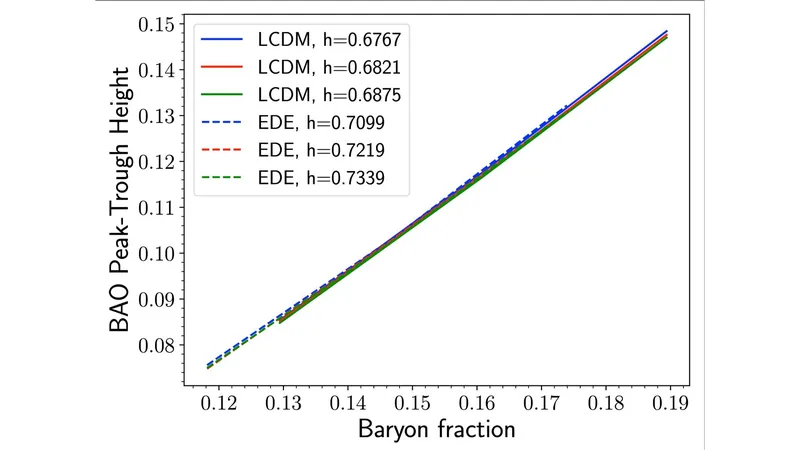
Breakthrough in Theoretical Physics: 'Supermazes' Unlock Secrets of Black Hole Microstructure!
2025-04-03
Author: Rajesh
Breakthrough in Theoretical Physics: 'Supermazes' Unlock Secrets of Black Hole Microstructure!
In a groundbreaking new study published in the Journal of High Energy Physics, a team of physicists has unveiled a revolutionary approach to unraveling the mysteries of black holes by mapping their intricate structures. These theoretical constructs, known as "supermazes," promise to redefine our understanding of black holes within the realms of theoretical physics, offering a microscopic perspective that was previously elusive.
According to Nicholas Warner, a professor of physics, astronomy, and mathematics at USC Dornsife and co-author of the study, “General relativity provides a powerful framework for describing the vast structure of black holes. However, it falls short when it comes to detailing their microstructure.” By integrating concepts from string theory, supermazes create a more detailed representation of the microscopic structure of so-called brane black holes—objects that defy our traditional understanding.
Redefining the Essence of Black Holes
Black holes, renowned for their ability to trap light due to their immense gravitational pull, challenge our comprehension in various ways. Conventional black holes, as described by general relativity, are thought to be surrounded by an event horizon, rendering them featureless from the outside. Yet, this simplistic view clashes with the principles of quantum mechanics, which suggests that black holes should harbor complex internal structures.
Warner explains that string theory posits an intriguing alternative: it conceptualizes black holes as “fuzzballs.” By utilizing supermazes, the researchers demonstrate that these fuzzballs can emerge from intricate arrangements of physical entities existing in higher-dimensional spacetime, providing a mechanism that allows these constructs to behave like black holes while showcasing their intricate structures.
Unlocking the Dimensions of M-Theory
The research dives deep into M-theory, an advanced theoretical framework interconnected with string theory. This theory suggests that the fundamental components of the universe—the strings—exist beyond just one dimension. Instead, they manifest as branes, or “membranes,” that extend across multiple spatial dimensions, playing crucial roles in the framework of M-theory.
Warner elaborates, “In this study, we delve into the interplay between M2-branes (two-dimensional) and M5-branes (five-dimensional) in the context of supergravity, which serves as a low-energy approximation of M-theory. We envision the maze as a substrate where all information about the formation of a black hole, or any matter that falls into it, can be encapsulated.”
The researchers discovered that these maze functions, which govern the intersections of branes, hold the potential to replicate black hole entropy and even describe the microstates of black holes themselves, a significant advancement in the field.
Innovative Strategies for Mapping Black Holes
While brane intersections have been a topic of extensive investigation within string theory, this latest research technology uses innovative mathematical constructs, termed “maze functions,” to yield fresh geometries that accurately depict black holes. The maze function adheres to a complex nonlinear differential equation reminiscent of the Monge-Ampère equation, known for defining the geometry and dynamics at play in the intersections of M2 and M5 branes.
Warner emphasizes the importance of these maze functions, stating, “They serve as the billion-pixel camera, allowing us to capture a vivid and intricate visual representation of the microstructure of black holes.” This advancement signifies just the initial step toward a broader initiative to fully elucidate the microstructural tapestry of brane black holes through string theory.
In summary, this pioneering research has the potential to transform our comprehension of black holes, bridging the gap between large-scale cosmic phenomena and the subatomic dynamics that govern our universe. As scientists eagerly anticipate the implications of these "supermazes," the quest to decode the secrets of black holes may soon yield more answers than ever before!



 Brasil (PT)
Brasil (PT)
 Canada (EN)
Canada (EN)
 Chile (ES)
Chile (ES)
 Česko (CS)
Česko (CS)
 대한민국 (KO)
대한민국 (KO)
 España (ES)
España (ES)
 France (FR)
France (FR)
 Hong Kong (EN)
Hong Kong (EN)
 Italia (IT)
Italia (IT)
 日本 (JA)
日本 (JA)
 Magyarország (HU)
Magyarország (HU)
 Norge (NO)
Norge (NO)
 Polska (PL)
Polska (PL)
 Schweiz (DE)
Schweiz (DE)
 Singapore (EN)
Singapore (EN)
 Sverige (SV)
Sverige (SV)
 Suomi (FI)
Suomi (FI)
 Türkiye (TR)
Türkiye (TR)
 الإمارات العربية المتحدة (AR)
الإمارات العربية المتحدة (AR)